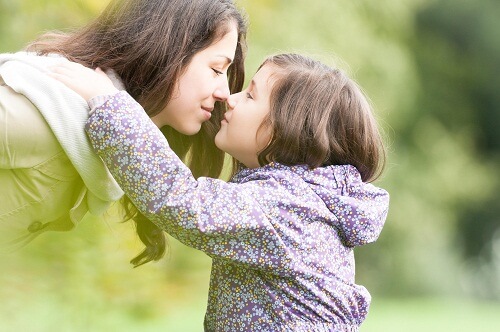Childhood Influences the Development of Personality

Childhood is an extremely delicate stage in which the development of personality takes place.
It is so important, in fact, that many of the problems that adults suffer originate as a result of this phase of their life.
We must keep in mind that everything that we experience during childhood leaves a footprint in our brains. It’s a footprint that we are not conscious of, but that affects us in certain ways.
Types of reinforcement and its importance on the development of personality

When it comes to educating kids, we can choose positive or negative reinforcement. The best thing to do is to find a middle ground between the two extremes.
- Positive reinforcement is when we celebrate the things that the children do well, ignoring what they do poorly or incorrectly. This may result in high self-esteem, which may make the child incapable of taking responsibility for his or her errors.
- Negative reinforcement, on the other hand, puts special emphasis on everything that the child does poorly. This can cause low self-esteem, which makes them think less of themselves, especially in comparison to those around them.
Both extremes are negative and influence the personality of any child. Because of that, if we have self-esteem issues as adults, taking a look at our childhood may show us why we are dealing with this.
Attachment to our parents marks us
Safe attachment

Safe attachment is when the child has all of their needs met by their mother.
There is physical contact, they know that if they need their mother, she will be there. Because of that, the child develops a healthy bond.
Anxious attachment
Anxious or ambivalent attachment develops when a child has a mother who is very attentive and caring in some occasions, but is cold and distant in others.
The consequence is that the child grows up with a lot of insecurity.
Avoidant attachment

Avoidant attachment develops because of insensitive mothers that tend to ignore the needs of their children.
Consequently, the children learn to reject them, to be independent and to not need them. In the future, they will have problems creating relationships with other people.
As we can see, safe attachment is the healthiest. However, anxious and avoidant attachment are more common than we think.
- A person who developed anxious attachment during childhood is very likely to suffer from emotional dependence in relationships with partners. This is because they have problems establishing healthy bonds and with being assertive.
- Someone who developed avoidant attachment during childhood will appear emotionally distant and, when someone starts to get close to them emotionally, they will run.
It is hard for these people to establish solid relationships with others.
The development of personality during childhood
As we have seen, the development of personality during childhood is very sensitive to the type of reinforcement and attachment that is generated, thanks to the relationship that parents maintain, especially mothers, with their children.
Thus, it is very beneficial to know how to give children the necessary attention, not allowing our own relationship problems to affect them and ensuring that we can offer them a safe attachment.
Unfortunately, parents do not usually keep this in mind and because of their responsibilities, work and their children’s constant need for attention, all of that falls into the background.
However, we cannot forget that personality development occurs during childhood, and that it is in the hands of the parents to do everything they can to avoid the possibility of their child having certain problems in the future.
Emotional dependency, the inability to establish affective bonds with other people, fear, insecurities in relationships…All of this doesn’t just come out of nowhere: it has a reason and that is found in one’s childhood.
All cited sources were thoroughly reviewed by our team to ensure their quality, reliability, currency, and validity. The bibliography of this article was considered reliable and of academic or scientific accuracy.
- Albert, M. A. R. T. A. (2007). Técnicas de modificación de conducta. Revista. http://www.praderwilliar.com.ar/archivos/libro/DOCS/pdf/ANEX-V.pdf
- Fernández, M. Á. R., GARCíA, M. I. D., & Crespo, A. V. (2012). Manual de técnicas de intervención cognitivo conductuales. Desclée de Brouwer. https://serproductivo.org/wp-content/uploads/2017/09/Manual-de-Tecnicas-Cognitivas-Conductuales-Marta-Isabel.-C.pdf
- Ramírez, M. A. (2005). Padres y desarrollo de los hijos: prácticas de crianza. Estudios pedagógicos (Valdivia), 31(2), 167-177. https://scielo.conicyt.cl/scielo.php?pid=s0718-07052005000200011&script=sci_arttext
- Páez, D., Fernández, I., Campos, M., Zubieta, E., & Casullo, M. (2006). Apego seguro, vínculos parentales, clima familiar e inteligencia emocional: socialización, regulación y bienestar. Ansiedad y estrés, 12(2-3), 329-341. https://www2.uned.es/dpto-psicologia-social-y-organizaciones/paginas/profesores/Itziar/IE_AEstres06.pdf
- Alonso–Arbiol, I., Shaver, P. R., & Yárnoz, S. (2002). Insecure attachment, gender roles, and interpersonal dependency in the Basque Country. Personal relationships, 9(4), 479-490. https://adultattachment.faculty.ucdavis.edu/wp-content/uploads/sites/66/2015/09/Alonso-Arbiol_2002_Insecure-attachment-gender-roles-and-interpersonal-dependency.pdf
- Garrido-Rojas, L. (2006). Apego, emoción y regulación emocional. Implicaciones para la salud. Revista latinoamericana de psicología, 38(3), 493-507. https://www.redalyc.org/pdf/805/80538304.pdf
This text is provided for informational purposes only and does not replace consultation with a professional. If in doubt, consult your specialist.








